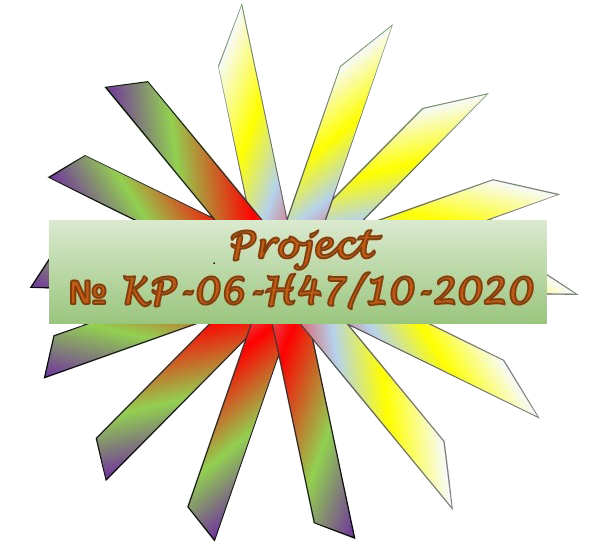Work programme for period 1
Tasks |
Participating researchers |
Duration (months) |
Expected results |
WP 1. Synthesis of DIOPSIDE- based ceramic pigments doped with d – transition elements and use of traditional raw materials |
Assoc. Prof. Dr. Ts. Dimitrov, Assoc. Prof. Dr. M. Stancheva, Assoc. Assoc. Prof. I. Nikolova, Ts. Ibreva PhD student, student Boyan Andreev, student G. Yankov. |
12 months From 1 to 12 month |
Synthesized ceramic pigments |
1.1. Synthesis of ceramics by solid-phase sintering method by introducing different d – transition elements: V, Cr, Mn, Ni, Co, Fe |
Ceramic pigments of different phase composition and colour will be synthesized via solid phase sintering method. |
||
1.2. Carrying out experiments on the synthesis of diopside-based ceramic pigments using a low-temperature sol-gel method. |
Diopside-based ceramic pigments synthesized via sol-gel method. The results obtained by the two methods will be compared. |
||
1.3. Determination of optimal parameters for pigment synthesis – firing and holding temperature at maximum temperature, type and amount of mineralizer. |
Experimental conditions and optimal synthesis parameters – firing temperature, sintering holding temperature and time will be specified. |
||
WP 2. Synthesis of DIOPSIDE- based ceramic pigments doped with f – transition elements and use of traditional raw materials |
Assoc. Prof. Dr. Ts. Dimitrov, Assoc. Prof. Dr. M. Stancheva, Assoc. Assoc. Prof. I. Nikolova, Ts. Ibreva PhD student, student Boyan Andreev, student G. Yankov. |
12 months From 7 to 18 month |
|
2.1. Synthesis of diopside-based ceramics using solid-phase sintering method by introducing chromophore f-transition elements: La, Pr, Nd, Er. |
Diopside-based ceramic pigments doped with rare earth elements will be synthesized |
||
2.2. Synthesis of diopside based ceramic pigments doped by f – transition elements via low temperature sol – gel method. |
Pigments will be synthesized via sol-gel method. The results obtained by the two methods will be compared. |
||
2.3. Determination of optimal parameters for synthesis |
Experimental conditions and optimal synthesis parameters will be specified. |
||
WP 3. Phase composition, structural characteristics, properties and mechanism of colour formation of synthesized pigments based on DIOPSIDE |
Assoc. Prof. Dr. R. Titorenkova, Assoc. Prof. Dr. Y. Tsvetanova, Prof. Dr. O. Petrov, Prof. Dr. M. Tarasov, Dr. S. Bakardjieva, student N. Kuvandzhiev |
15 months From 4 to 18 month |
Full characterization |
3.1. Characterization of pigments obtained by X-ray powder diffraction analysis (XRD), IR spectroscopy (FT-MIR and NIR), Raman spectroscopy, scanning electron microscopy (SEM), transmission electron microscopy (HR TEM), optical spectroscopy (UV-VIS-NIR) colour, electron paramagnetic resonance (EPR), photometric measuring, etc. |
Phase and chemical composition, morphology, structural features, optical and colour characteristics of the obtained ceramic pigments will be investigated. |
||
3.2. Mechanisms of isomorphic substitution in the crystalline structure of the basic phase. Mechanisms of colour formation. |
Clarifying the mechanism of isomorphic substitution. Clarifying the mechanisms of colour formation. |
||
3.3. Correlation dependencies between composition-structure-properties of the newly obtained ceramic pigments |
Dependencies between composition-structure-properties will be formulated. |
Work programme for period 2
Tasks |
Participating researchers |
Duration (months) |
Expected results |
WP 4. Synthesis of AUGITE-based ceramic pigments doped with d – transition elements and use of traditional raw materials |
|
12 months From 19 to 30 months |
|
4.1. Synthesis of augite-based pigments by solid-phase sintering method by introducing different d – transition elements: V, Cr, Mn, Co, Fe. |
Assoc. Prof. Dr. Ts. Dimitrov, Assoc. Prof. M. Stancheva, Assoc. Prof. I. Nikolova, PhD student Ts. Ibreva, B. Andreev, G. Yankov; Assoc. Prof. Dr. R. Titorenkova, student N. Kuvandzhiev |
Synthesised Augite-based ceramics with d – transition elements |
|
4.2. Determination of optimal parameters for pigment synthesis – firing and holding temperature at maximum temperature, type and amount of mineralizer. |
Experimental conditions and optimal synthesis parameters will be specified. The limitations will be clarified. |
||
4.3. Characterization of pigments by X-ray powder analysis (XRD), IR spectroscopy (FT-MIR), Raman spectroscopy, scanning electron microscopy (SEM), transmission electron microscopy (HR TEM), optical spectroscopy (UV-VIS-NIR) colour coordinates, etc. |
Assoc. Prof. Dr. R. Titorenkova, Assoc. Prof. Dr. Y. Tsvetanova, Prof. Dr. O. Petrov, Prof. Dr. M. Tarasov, Dr. S. Bakardjieva, student N. Kuvandzhiev |
Full characterization |
|
WP 5. Synthesis of DIOPSIDE and AUGITE-based ceramic pigments using Waste materials |
|
14 months From 22 to 36 months |
|
5.1. Characterization of the waste catalysts |
Assoc. Prof. Dr. R. Titorenkova, Assoc. Prof. Dr. Y. Tsvetanova, Prof. Dr. O. Petrov, Prof. Dr. M. Tarasov, Dr. S. Bakardjieva, student N. Kuvandzhiev |
Full characterization |
|
5.2. Synthesis of pigments by solid-phase sintering method using waste materials. Determination of optimal parameters for pigment synthesis – firing and holding temperature, type and amount of mineralizer, etc |
Assoc. Prof. Dr. Ts. Dimitrov, |
Synthesised pyroxene-based ceramics using appropriate waste materials. |
|
5.3. Characterisation of pigments by X-ray powder analysis (XRD), IR spectroscopy (FT-MIR), Raman spectroscopy, scanning electron microscopy (SEM), transmission electron microscopy (HR TEM), optical spectroscopy (UV-VIS-NIR), colour coordinates, etc. |
Assoc. Prof. Dr. R. Titorenkova, Assoc. Prof. Dr. Y. Tsvetanova, Prof. Dr. O. Petrov, Prof. Dr. M. Tarasov, Dr. S. Bakardjieva, student N. Kuvandzhiev |
Full characterization |
|
WP 6. Publicity of the project |
|
36 months 1-36 month |
|
6.1. Designing a project website in order to maximize the visibility of project results |
Assoc. Prof. Dr. Ts. Dimitrovand all members of the team |
Website of the project |
|
6.2. Publications in scientific journals Participation in selected scientific conferences |
4 papers published in scientific journals with IF or SJR and 8 papers published in conference reports. |
||
6.3. Innovative activity |
At least one application for Utility Model or Patent |
